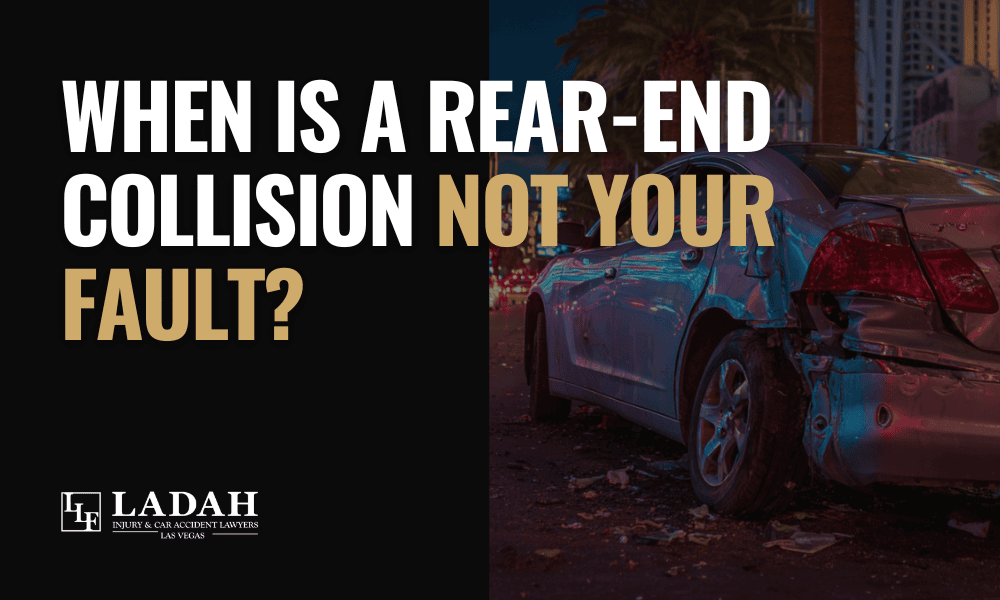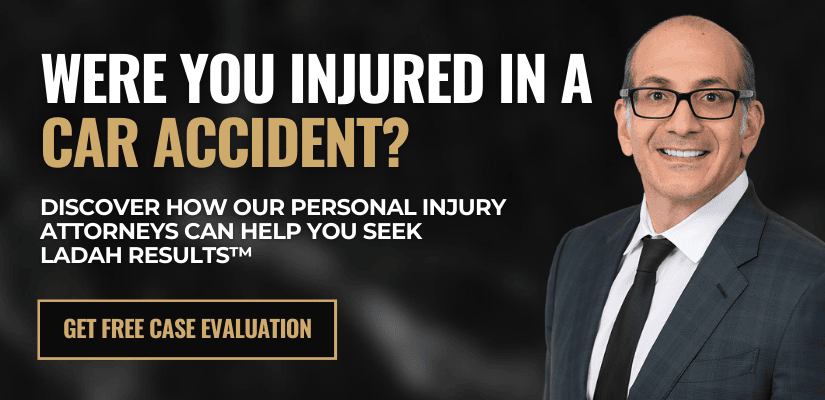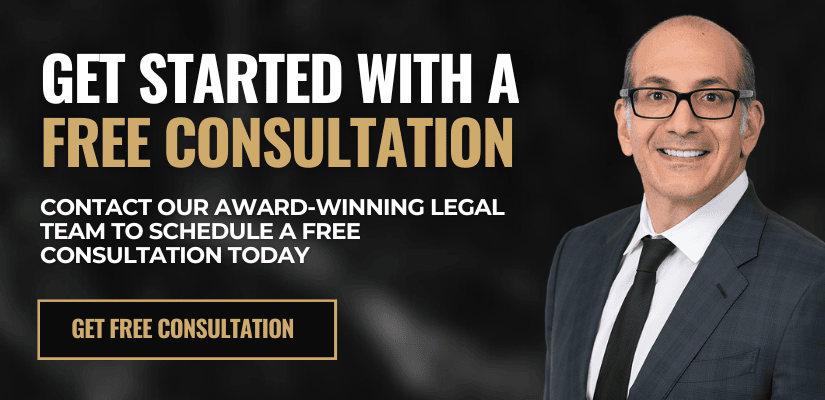A rear-end collision in Nevada may not be your fault if the driver ahead braked suddenly for no reason, reversed into you, had faulty brake lights, or made an abrupt lane change. If another vehicle pushed you forward into the car ahead, you may not be liable. Nevada’s comparative negligence law allows shared fault, so evidence and witnesses are important.

Rear-end collisions are among the most frequent types of car accidents on our roads, often leading to confusion and disputes over who is at fault.
While it is commonly assumed that the driver who hits another vehicle from behind is always responsible, the reality can be more complex. Various factors such as sudden stops, mechanical failures, or unsafe driving decisions by the front driver can shift or share liability. Understanding these exceptions is crucial for protecting your rights and ensuring fair treatment in insurance claims.
In this article, Ramzy Ladah, award-winning car accident lawyer, explores a common question we hear from people who have recently been in a rear-end accident in Las Vegas and believe it was not their fault – when is a rear-end collision not your fault?
Understanding Fault in Rear-End Accidents
Rear-end collisions are among the most common types of car accidents on the road. Typically, the driver who hits the vehicle in front from behind is presumed to be at fault due to the expectation of maintaining a safe following distance and being prepared to stop safely.
However, the reality is often more complex. Various factors such as the front vehicle’s brake lights malfunctioning, sudden stops by the front driver, or hazardous road conditions can shift or share liability.
Understanding when a rear-end collision is not your fault is essential for protecting your rights and navigating insurance claims effectively.
Common Situations Where It’s Not Always Your Fault
While rear-end collisions are often assumed to be the fault of the driver in the rear, this is not always the case. Various factors, including the actions of the front driver, road conditions, and mechanical issues, can contribute to the accident and shift or share liability.
Understanding these exceptions is crucial for protecting your rights after a collision.
Here are some of the most common situations where a rear-end collision may not be your fault.

Sudden and Unexpected Stops by the Other Driver
One of the most common exceptions to the rear driver’s negligence is when the front driver makes a sudden and unexpected stop.
In Las Vegas, traffic can be unpredictable, and sometimes the front driver may slam on their brakes without any apparent reason. This abrupt action leaves little to no time for the rear vehicle to react, making the collision unavoidable.
Such stops might be caused by distractions, erratic driving, or even intentional brake checking—a dangerous practice where the front driver purposely brakes hard to intimidate or cause a crash.
If you can demonstrate that the front driver stopped suddenly without cause, liability may shift away from you.
Gathering witness statements, traffic camera footage, or dash cam video can be crucial to prove fault in these situations.
Faulty Brake Lights or No Brake Lights
Brake lights are a critical communication tool on the road, signaling when a driver intends to slow down or stop.
If the front vehicle’s brake lights are malfunctioning or completely non-functioning, the rear driver may have no warning of an impending stop.
If you hit a vehicle whose brake lights were not functioning properly, you might not be held liable, as the front driver’s failure to maintain their vehicle contributed to the accident.
Police reports and vehicle inspections can help prove that malfunctioning brake lights were a factor, supporting your claim against unfair liability claims.
Rear-End Collisions Involving Multiple Vehicles
Multi-car accidents, or chain-reaction crashes, complicate fault determination. In these situations, multiple drivers may be involved in a series of rear-end collisions, often triggered by one initial sudden stop or accident.
If you are in the middle of such a pileup and were pushed into the car ahead by another vehicle, you may not be fully responsible for the damage.
Liability can shift or be shared among multiple drivers depending on the circumstances.
Accident scene analysis, skid marks, and witness statements are important evidence to establish the sequence of events and prove that you were not the at fault driver.
Consulting legal guidance is advisable to navigate these complex cases.
Being Pushed Into Another Car (Chain Reaction Car Accidents)
Sometimes, a rear-end collision occurs because a vehicle behind you crashes into your car, pushing you forward into another vehicle. In these chain reaction accidents, the fault may lie with the driver who initiated the collision from behind rather than you.
If you maintained a safe distance and were forced into the front vehicle due to the impact from behind, you can contest fault.
Gathering evidence such as traffic camera footage, witness statements, and police reports will be essential to prove that the accident occurred due to the actions of the rear vehicle.
This distinction is crucial in Las Vegas, where multi-vehicle accidents are common on busy roads.
Illegal or Reckless Actions by the Other Driver
The front driver’s illegal or reckless behavior can be a significant factor in shifting liability. Examples include abrupt lane changes without signaling, unsafe merging, or reckless driving that forces you to brake suddenly.
In some cases, the front driver may even be under the influence of alcohol or drugs, impairing their judgment and reaction times.
If you can prove that the front driver’s unsafe driving decisions contributed to the accident, you may avoid being held responsible. Evidence like police reports, witness statements, and video footage can support your claim.
Seeking legal guidance ensures your rights are protected when contesting fault based on the front driver’s actions.
Mechanical Failures Beyond Your Control
Mechanical failures in your vehicle or the front vehicle can cause unavoidable accidents. For instance, if your brakes fail despite proper maintenance, or if the front vehicle experiences brake failure or steering issues, the collision may be deemed unavoidable.
In Las Vegas, extreme heat can exacerbate mechanical problems, increasing the risk.
To prove fault in these cases, maintenance records and vehicle inspections are critical. Demonstrating that you took all necessary precautions and that the mechanical failure was unforeseeable can help shift liability away from you.
Consulting an experienced personal injury attorney can assist in navigating claims involving mechanical failures.
Road Hazards and Weather Conditions
Unexpected road hazards or adverse weather conditions can contribute to rear-end collisions and affect fault determination.
Debris in the roadway, potholes, or sudden obstacles may force drivers to brake abruptly. Similarly, rain, fog, or dust storms common in Las Vegas can reduce visibility and increase stopping distances.
If you were driving safely and maintaining a safe distance but an unavoidable accident occurred due to these external factors, you may not be held liable.
Documentation such as photos of the accident scene, weather reports, and witness statements can support your case.
Legal guidance can be vital to contesting fault when road hazards or weather conditions play a role.
Proving You Were Not at Fault as the Rear Driver
Proving you were not at fault in a rear-end collision requires careful evidence gathering and clear communication. This section guides you through essential steps to document the accident, work with insurance companies, and seek expert legal support effectively.
Gathering Evidence After a Rear-End Accident
To prove that you were not at fault in a rear-end collision, it is crucial to collect strong and clear evidence immediately after the accident. This documentation will support your claim and help establish the circumstances that contributed to the crash.
Here is a checklist of key evidence you should gather at the scene and afterward:
- Clear photos and videos of all vehicle damage
- Images of skid marks and road conditions
- Photos of traffic signals and any visible hazards
- The exact position of all vehicles involved
- Contact information and statements from witnesses
- Traffic camera or dash cam footage capturing the accident
- A copy of the police report with officer observations and citations
- Records of medical treatments related to the accident
- Documentation of vehicle repairs following the collision
Collecting this evidence thoroughly will strengthen your case and assist in proving that the front driver’s actions or other factors contributed to the accident.
Working with Insurance Companies
Dealing with insurance adjusters can be challenging, especially when fault is contested. It is important to communicate carefully and avoid admitting fault or making statements that could be construed as accepting blame. Provide factual and concise information about the accident without speculation.
Notify your insurance company promptly and provide them with all the evidence you have gathered. If the other party’s insurance company contacts you, consider consulting an experienced car accident attorney before giving detailed statements to ensure your rights are protected.
Insurance adjusters evaluate claims based on available evidence, and having strong documentation can significantly influence their determination of fault. If liability is disputed, legal guidance can help you navigate negotiations and ensure you receive fair compensation for damages and injuries.
When to Consult an Experienced Car Accident Attorney
Consulting an experienced car accident attorney is advisable as soon as possible after a rear-end collision, especially if you believe you were not at fault. An attorney can help you understand your legal rights, gather and analyze evidence, and build a strong case to contest liability.
Legal professionals have the expertise to deal with insurance companies and can advocate on your behalf to maximize compensation for medical expenses, vehicle repairs, lost wages, and other damages. In complex cases such as multi-car accidents, mechanical failures, or when the front driver’s negligence is involved, an attorney’s guidance is invaluable.
If the insurance company denies your claim or attempts to unfairly assign blame, an experienced personal injury attorney can take legal action to protect your interests. Early consultation ensures that critical evidence is preserved and deadlines for claims or lawsuits are met, improving your chances of a successful outcome.
Were You in a Rear-End Accident in Las Vegas?
Have you recently been involved in a rear-end collision and believe it was not your fault? Don’t let the insurance companies or other drivers unfairly assign blame.
At Ladah Injury & Car Accident Lawyers Las Vegas, we specialize in handling complex rear-end accident cases. Our experienced legal team understands the nuances of liability and will fight to protect your rights and secure the compensation you deserve.
Our award-winning personal injury attorneys will stand by your side, gather all crucial evidence, negotiate with insurance adjusters, and advocate aggressively on your behalf. When you choose Ladah Injury & Car Accident Lawyers Las Vegas, you gain a trusted partner dedicated to protecting your recovery and financial interests.
Contact us today to schedule a free consultation – available 24/7!

Frequently Asked Questions
1. How do I avoid admitting fault after a rear-end accident?
Avoid admitting fault by staying calm and providing only factual information to police and insurance companies. Do not apologize or speculate about the cause. Focus on gathering evidence and reporting the incident accurately. Consult an experienced car accident attorney before making any statements to protect your rights and avoid unintentionally accepting blame.
2. Who is usually responsible in a multi car accident involving rear-end collisions?
Responsibility in multi-car rear-end accidents depends on the sequence of events. Typically, the driver who initiates the collision is at fault. However, drivers pushed into others may share or avoid liability. Accident reconstruction and evidence like skid marks and witness statements help determine fault distribution among multiple drivers.
3. How can I prove I wasn’t at fault in a rear-end collision?
Prove non-fault by collecting strong evidence such as photos, witness statements, traffic camera footage, and police reports. Demonstrate factors like sudden stops, malfunctioning brake lights, or being pushed by another vehicle. Documentation of road conditions and vehicle maintenance can also support your claim. Legal guidance can help present this evidence effectively.
4. What evidence is most important after a car accident?
Critical evidence includes clear photos of vehicle damage and accident scene, witness contact information and statements, police reports, and any available video footage like dash cams or traffic cameras. Skid marks, road conditions, and vehicle maintenance records can also be vital in establishing fault and supporting your case.
5. When should I contact an experienced car accident attorney?
Contact an attorney promptly after a rear-end collision, especially if fault is disputed or injuries occurred. Early legal advice ensures proper evidence collection, protects your rights during insurance negotiations, and helps you navigate complex claims. Consulting an attorney soon improves your chances of receiving fair compensation.
Conclusion
While rear-end collisions typically place fault on the rear driver, exceptions exist where liability may shift due to the front driver’s actions, mechanical failures, or external factors.
Gathering strong evidence and seeking legal guidance are essential to protect your rights and prove the collision was not your fault.
Consulting an experienced car accident attorney can help navigate complex cases and ensure fair treatment in insurance claims.

